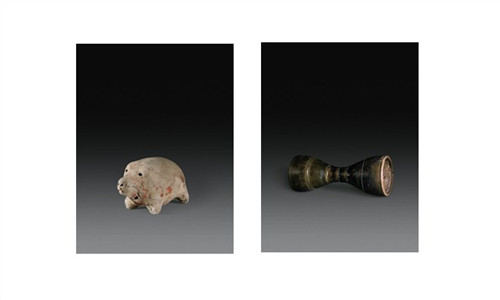

An artifact on show at the Tracing History: Archaeological Discoveries in Shanghai exhibition Photos: Courtesy of the Shanghai Museum
Regarded as the best-preserved skull of the earliest people to inhabit the Shanghai region, the skull unearthed at Songze in Qingpu district in 2004 is over 6,000 years old. It is currently on show as part of the Tracing History: Archaeological Discoveries in Shanghai exhibition at the Shanghai Museum, which lasts until the end of August.
"This skull has been identified as being that of a male aged 25 to 30," Chen Jie, deputy director of the archeology research department of the Shanghai Museum, told the Global Times. "We call it 'Shanghai's first man.' It is difficult to figure out how the man may have looked, but we can imagine the hardship he faced fighting dangerous animals like tigers, bears and lions while cultivating rice."
Over 500 locally unearthed artifacts from various periods are also being shown at the exhibition, including Neolithic jades, bronzes from the Spring and Autumn Period (770BC-476BC), goldware from the Yuan Dynasty (1279-1368) and some religious objects from the Ming Dynasty (1368-1644) and the Qing Dynasty (1644-1911).
"The exhibition is the most complete public display of the achievements of the past 60 years of archeological work in Shanghai, with many exhibits open to the public for the first time," Song Jian, director of the archeology research department of the Shanghai Museum and chief curator of the exhibition, told the Global Times.
The exhibition is split into three parts. According to Song, "Light of Civilization" probes the origin and evolution of prehistoric Shanghai; "Process of Urbanization" celebrates the urbanization of ancient Shanghai; while "Hidden Relics from Pagodas" unveils the cultural essence of the developing metropolis through treasures from the city's 13 existing Buddhist pagodas.
Light of civilization
The "Light of Civilization" section houses the Songze skull, along with tools and utensils used to manufacture handicrafts from around 6,000 to 3,200 years ago.
"They vividly show the daily life of early inhabitants of prehistoric Shanghai," said Chen Jie, who curates this section. "They were not only intelligent manufacturers, but also romantic artists."
In the period of Songze culture (around 6,000 to 5,400 years ago), people made clay figurines in shapes of animals such as pigs (pictured below) and turtles, as well as in shapes of bamboo. People had also learned how to carve patterns into pottery.
According to Chen, prehistoric Shanghai can be divided into two periods. The first encompasses the Majiabang, Songze and Liangzhu cultures (around 6,000 to 4,300 years ago), which represent the peak of Neolithic development. The second lasts from the Guangfulin culture to the Maqiao culture (around 4,100 to 3,200 years ago), which saw the transition out of the Neolithic Age to that of recorded history.
During the period of the Guangfulin and Maqiao cultures, people from North China and South China increasingly interacted with each other in the area of Shanghai. "In fact, from then on, Shanghai has been an important artery for culture and trade in China, developing its characteristic openness," Chen said.
Process of urbanization
Baihe town in Qingpu district is the earliest town in Shanghai, built during the Tang Dynasty (618-907).
"The building up of that area can be regarded as an important point during the process of urbanization in Shanghai," Zhai Yang, the curator of the section "Process of Urbanization," told the Global Times.
In recent years, many fine porcelain pieces from the Tang and Song dynasties originating from provinces like Zhejiang and Hunan have been unearthed in this area.
"They show that Baihe town at that time was a very prosperous place," Zhai said.
A brown glazed porcelain waist drum (pictured above) on show at the exhibition was also unearthed in Baihe town. According to Zhai, the waist drum was a very popular musical instrument during the Tang Dynasty, and can be played while seated or while standing and walking.
A piece of brick on show at the entrance to the exhibition section was unearthed in Qingpu district, and is from the Han Dynasty (206BC-AD220). The patterning on it is the same as that found on brick at the Weiyang Palace, an imperial palace complex of the Han Dynasty located in Xi'an.
"It could be inferred that there were nobles or rich people living in Shanghai in the Han Dynasty, and that Shanghai's urbanization process had probably started by this time," Zhai said.
Ancient pagodas in Shanghai
At the entrance of the exhibition to the "Hidden Relics from Pagodas" section is a map showing the locations of the existing 13 pagodas in Shanghai. They are mainly scattered across Songjiang, Qingpu, Jiading, Jinshan and Xuhui districts. The oldest of them is the well-known Longhua Pagoda in Xuhui district, dating back to the Three Kingdoms (220-280).
According to He Jiying, the curator of the section, except for the Nanxiangsi double pagodas in Jiading district which are made primarily of brick, all the pagodas in Shanghai were made of a combination of wood and brick. "Most of these pagodas were originally built for religious purposes."
Since the 1970s, Shanghai has carried out conservation work on the pagodas, during which large amounts of precious Buddhist statuettes and artifacts made of jade and agate were discovered. Many of these are on display at the exhibition.
Date: Until August 31, 9 am to 5 pm
Venue: No.1 to No.3 Exhibition Halls of Shanghai Museum
Address: 201 People's Avenue
人民大道201号
Admission: Free
Call 6372-3500 for details
Copyright ©1999-2018
Chinanews.com. All rights reserved.
Reproduction in whole or in part without permission is prohibited.